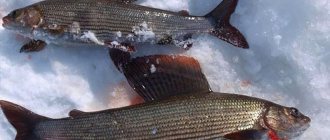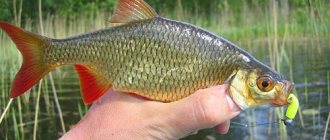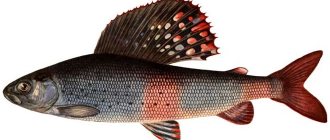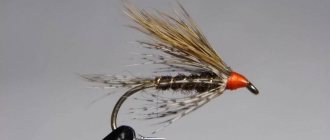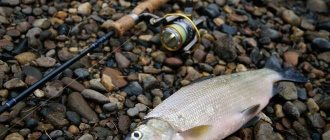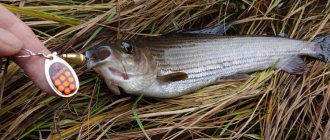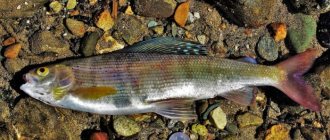Freshwater bodies of Russia are rich in various fish, but the most unusual, perhaps, is grayling. Take his appearance, for example. It is very different from its closest relatives, which are the salmon family. Variegated colors, a sail-shaped dorsal fin dotted with bright spots, strong scales reminiscent of the chain mail of a medieval knight... Near the tail there is an adipose fin, indicating the involvement of this fish in salmonids. This only increases the value and importance of grayling in the eyes of fishermen.
Catching grayling is no less interesting than its appearance. He is cunning, cautious and timid, so the success of such fishing will depend on the experience of the fisherman, knowledge of special fishing techniques and ability to handle the selected gear. In addition, you need to know what environment grayling prefers to live in, otherwise your search may be fruitless. For example, he loves fast rivers with cold water, but can live in warm bodies of water, but polluted ones are not for him. He fails to adapt to such conditions.
Where to catch grayling
This fish is mainly distributed in the northern part of the country - Siberia, Irkutsk, Perm Territory, Krasnoyarsk. It can live in large rivers and mountain streams, in large deep-water lakes and shallow oxbow lakes. Grayling feels most comfortable in a clear mountain river with a rocky or pebble-strewn bottom. But this choice is precisely what creates difficulties for the fisherman. The fact is that due to the high transparency of the water, getting close to the object of fishing unnoticed is very problematic. This fish has excellent eyesight, and the large number of large predators that live in northern waters forces it to always be ready. Sensing the slightest threat or catch, she quickly leaves the dangerous place.

You need to look for grayling on rifts, near pools, behind fallen trees and boulders. Large specimens occupy the most favorable places for feeding, namely whirlpools, where a lot of different food lingers. When hunting, grayling uses a wait-and-see tactic. He is not inclined to chase prey, as perch or pike often do. He patiently hides in cover and carefully looks up. As soon as the current brings something tasty (for example, an insect that accidentally fell into the water), the grayling immediately rushes across and grabs the floating insect just below its ambush site. To figure out such a parking lot, you just need to look carefully at the water. If insects disappear from the surface one after another and all this is accompanied by small splashes, there is no doubt that this is the work of grayling.
The bait must be presented exactly above the parking area; if it passes to the side, the fish will not react to it. That is why fishing a promising place often takes a lot of time; you have to make several casts to almost the same point in order to get the bait as close to the parking lot as possible.
Grayling - Features and habits
This is a strong, agile, swift fish. Its fishing, like trout fishing, requires great skill.
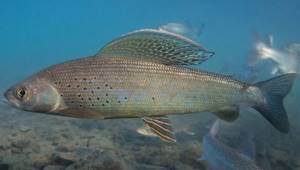
Grayling lives in streams and upper reaches of cold, spring rivers, and is especially abundant in the rivers of the north and northeast of our country. It can move high in hollow water, sometimes to the very sources of streams. Some remain here in the holes until the autumn flood, with which they roll down for the winter.
In large rivers it stays away from the banks. On small rivers and streams it loves reaches of medium depth - above and below rapids and riffles, rapids in the middle reaches, and occupies holes between rapids. Always sticks to more open places, but close to shelters.
From the depths it controls the surface of the water and therefore prefers the place where the ripples of a riffle, rapids, or rapids end. During the day, it often hides in shelters under trees and bushes hanging over the shore. In the morning and evening it walks near the shores.
Ripples in the water from the wind greatly help camouflage the angler and make fishing more successful.
In spring, bark beetles and mobile, live worms are good baits.
In summer, grayling prefer a rocky-pebble bottom and riffles, and in late autumn a sandy bottom, mainly on river bends and reaches.
It can reach 2.5 kg, but fishermen more often come across specimens weighing 300–500 g. On rivers, grayling rarely reach a weight of more than 1 kg.
In northern lakes, graylings live on rocky, pebble and, less commonly, coarse sandy shallows. They often change their mooring sites, but do not go into deep bays and bays, and also do not go among algae. They always prefer to stay near the surf shore.
Hunting for insects, it jumps out of the water, thereby revealing its presence.
It spawns in several stages, spawning coincides with the flowering of bird cherry and continues until the gardens fade.
The grayling can then continue to rise upstream in the river, and the hotter it gets, the higher it rises.
Large graylings often stay alone, and small ones in small schools.
At the beginning of summer, the best bait is shitik; in summer - all kinds of insects, preferably the caddis butterfly (shitika). In autumn, in September and November, grayling is especially bold and voracious, and is caught using a moving worm and minnow.
The most sporting way of catching grayling is fly fishing, but with the advent of reel fishing, especially spinning reels, it is being replaced by wiring. Fly fishing is described in detail in the books of many authors, so there is no need to repeat it.
Fishing in a retrieve with a long release of the float begins from the time of a fairly noticeable drop in the flood level, clarification of the water and until the appearance of aerial insects. It is more successful on bark beetles, worms and shitica. This fishing ends with the beginning of freeze-up. In autumn, the bite is best around noon and in the evening twilight. With the appearance of sludge, grayling slides downstream into the deep sections of the river.
It is also possible to catch grayling from the ice. It does not stop feeding in winter. But with the beginning of trout spawning, grayling does not take bait, feeding on its eggs. It can be caught from the ice using small spoons and jigs.
The best spinner is narrow, up to 50 mm long, one side is silver, the other is made of red copper. The inner side must be brought to a matte shine. Fish often disappear from a single hook; it is better to hang a double hook No. 5–6 and disguise it with gray feathers, or even better, bait it with a piece of worm.
The tactics for fishing with lures are no different from trout fishing; the pace of lure fishing is the same as for perch. After catching one, or less often two, grayling, you should not wait for bites in the same place - the fish are scared.
Just like when fishing for trout, the angler does not stay in one place for long; he constantly moves downstream, fishing every suitable place. You should not move upstream - frightened grayling, like trout, always rushes upstream and alerts others here.
Caution, camouflage and keeping quiet movements when fishing for grayling are needed no less than when fishing for trout. Frequent casting alarms grayling even more than trout. You need accuracy on the first cast, on the first retrieve. As a last resort, if a hidden approach is impossible, you need to go up and lie down, hide for 5-10 minutes, and then cast the tackle.
Grayling is also caught using bottom fishing (on large rivers), spinning rods and boats (on lakes).
When fishing on top, seasonal alternation of insects is used: they try to catch those that are currently flying over the reservoir. In the spring - stoneflies and caddisflies, in the summer - mayflies, botflies and butterflies, and then - grasshoppers. Fishing with artificial flies is only possible in fast currents and during ripples in the water. In calm weather and at depths, it is better to fish with natural insects.
The grayling bite is lightning fast and sharp, but it can sense deception and quickly spit out the bait, so the hook should be immediate after the bite.
Grayling's lips are weak; it must be fished out smoothly, using the bend of the rod.
The gear is the same as for trout, but the hooks are smaller - No. 4–5.
When taken out of the water, grayling quickly falls asleep and deteriorates faster than trout in hot weather. Fish caught in the summer must be immediately gutted, the gills removed and placed in a bag, covered with nettles or bird cherry.
The smell of freshly caught grayling is characteristic - it smells like a young, fresh cucumber. Grayling meat has no bones. Its taste is cancelled, it is especially good in a pie.
Local names for grayling are lepenya, totopets, haryoz, and lipen.
Share on social networks:
Omnivorousness of the fished object
Grayling does not disdain juveniles of other species, so it can safely be called a predator. He does not refuse the caviar of other inhabitants of the reservoir. Larvae, worms, mollusks and other underwater creatures are also included in its diet. But the greatest delicacy for him are insects: grasshoppers, dragonflies, gadflies, mosquitoes, midges, and so on. Fishermen have long noticed this taste preference and successfully catch it with homemade and factory-made artificial flies made from animal hair, feathers and other similar materials.
Grayling fishing in the Arkhangelsk region
The Arkhangelsk region is located in the north of our country. In terms of fishing, the greatest interest for anglers are the numerous rivers. All the rivers available in this area can be very roughly divided into several main groups, using as criteria not only such characteristics as the volume of the spillway and the general characteristics of the flow, but also the absence/presence of thresholds, and also taking into account the diverse features inherent in the coastlines in these places. Grayling fishing in the Arkhangelsk region is a very popular and effective activity, thanks to such a wide variety of rivers represented in this part of the country.
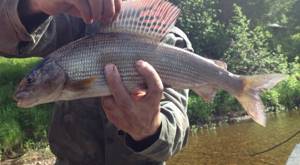
The first group includes those rivers that are small in size and not navigable. Traveling through these bodies of water is only possible along long coastlines on foot, which is quite inconvenient. In this case, the most convenient time for catching grayling will be at the beginning of summer, since at this time the coastal vegetation is not very developed, which leaves the possibility of movement on foot. In addition to grayling, in such rivers you can find quite a lot of different fish, including salmon and pink salmon, which is the dearest trophy of any fisherman. For fishing in such rivers, a so-called telescopic rod is required, which is quite convenient for fishing in such conditions. Grayling fishing in the Arkhangelsk region proceeds much more vigorously if those rivers that flow into lakes that are quite impressive in size are chosen for it. Fishing in the Arkhangelsk region, in such conditions, involves using kayaks or something similar. In addition to grayling, it is quite easy to find noble fish species here, such as trout. Thanks to such features, this category of rivers is distinguished from the previous one.
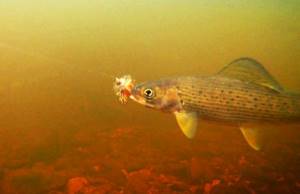
The third group of rivers in this area are those in which the use of boats is permissible and which have average widths. The most appropriate way to fish in such rivers is from the banks, which are especially steep here, which is quite convenient, given the fact that grayling, perch and pike are most often found in this category of reservoirs. The water in these rivers can either have a unique color or be clean. If fishing is done using a boat, you should carefully inspect the length of the river for the presence of various blockages, which are not uncommon in such places. The fourth group allows the fisherman to rejoice, since in addition to the already listed variety of fish, the rivers of this category also contain such wonderful representatives of the fish fauna as sterlet, bream, and pike perch. Rivers of this category are distinguished primarily by the fact that they are full-flowing and are often navigated by navigation. The most preferred places for fishing are various channels, bays and other similar places. The most preferred fishing period is summer, however, you can fish in large rivers in winter, since they never freeze completely, unlike smaller varieties. Grayling fishing in the Arkhangelsk region is quite a productive activity if you approach correctly not only the choice of fishing location, but also the bait. For the most part, the baits used, such as various flies and insects, are similar to those recommended for use in the middle zone. However, larger flies are suitable for fishing in these areas, as this prevents the fish from swallowing the bait excessively, as a result of which it suffers quite serious injuries, which is unacceptable in a catch-and-release fishing pattern.
Tackle for grayling fishing
Grayling fishing in spring, summer and the first half of autumn is possible using several different types of fishing gear. The first place in popularity is taken by the spinning rod, followed by fly fishing tackle and the float rod closing the top three. In the hands of a competent fisherman, any of them can turn out to be very productive, so let’s take a closer look at all of the listed fishing methods.
Spinning
The catchability of a spinning rod in grayling hunting depends on the fisherman’s ability to correctly select the elements of tackle, bait and fishing technique. Experienced spinning anglers recommend using a lightweight ultralight rod, since you will have to fish with miniature baits. Grayling are most interested in small spinners that imitate small fish. The most catchy size is No00, but on Siberian rivers, where impressive specimens weighing up to 3 kg are found, you can use larger spinners or even try fishing with spoons. The requirements for the reel are extremely simple: ease of movement, proper installation, low weight and dimensions. A braided cord with a cross-section of up to 0.12 mm is suitable as the main fishing line. Based on the strength/stealth ratio, then this is an ideal option.
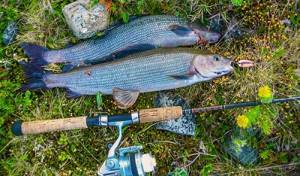
An oscillating spoon can provoke a fairly large fish to bite, but you shouldn’t count on frequent bites. If there is a large number of graylings in the reservoir and they are active, then it is better to choose No00 spinners. First of all, this advice is addressed to beginners who have just begun to master the basics of spinning fishing for the Siberian beauty. It is better to gain experience and hone your skills on a small fish, and besides, the possibility of a trophy specimen being bitten by a rotating spinner is also not excluded.
Success will largely depend on the quality of the wiring. When fishing for grayling with a spinning rod, it should be uniform and as slow as possible. The bait should be on the verge of failure, but the petal should not be allowed to stick. That is why you need to buy only high-quality turntables and first check their performance with the help of leisurely wiring in shallow coastal waters. When fishing, it is advisable to choose a point on the shore of a relative promising area in order to cast the tackle perpendicular to the river. A spinner, which moves under the influence of two forces simultaneously - the reel and the water flow, becomes an ideal bait for grayling.
It has been noticed that on clear sunny days the fish prefer lures with copper petals, while in cloudy and rainy weather they are more interested in lures with a silvery sheen.
Of course, this is not the rule for all reservoirs without exception, because the taste preferences of fish even in neighboring rivers or lakes can differ radically.
Features of catching grayling in autumn with a spinning rod
Experienced fishermen advise having a spinning rod at your disposal, with which you can catch grayling at different distances from the shore. Most often, in mid-autumn, medium-sized spinners are used as bait, which quickly reach the bottom where the fish are located after hitting the water.
It is important to note that it is not uncommon for grayling to react to a falling bait, so after casting you must always be ready to hook.
In addition to spinners, anglers use crankbait wobblers, as well as sinking minnows; it is rare to see an angler using shad in the fall.
You need to approach the choice of fishing line with special responsibility; we note that it is recommended to abandon the braided cord , since it is noticeable in the water and alarms the fish, which is why the number of bites sharply decreases. Professionals advise winding fluorocarbon line with a cross-section of 0.2 mm onto the spool of your reel.
Fishing with a spinning rod is especially convenient in sections of the river with washed-out banks, where trophy fish are often found.

Catching grayling in winter with jigs, features

For fishing, jigs weighing 2 grams or more are selected (depending on the fishing conditions, namely the depth and strength of the current). The equipment can be supplemented with one small hook, which, using a leash, is fixed to the main fishing line above the jig at a distance of 15-20 cm.
A burdock larva, maggots, and worms are attached to the hook. It is important to note that as natural bait you should select only options that are well known to grayling, that is, those that the predator is accustomed to feeding on in its natural habitat.
Important! Fishing success will be guaranteed; if there is live bait on the hook, grayling may not respond to a sluggish bait.
Now a few words about jigs; for catching grayling, it is best to choose golden-colored options. You can wrap a little red wool thread on the hook - this will increase the attractiveness of the bait.
It is important to pay special attention to technology. So, after the jig reaches the bottom, there is a short pause, after which a jerk is made with a sharp wrist movement. It is enough for the jig to come off the bottom by 10-15 cm, after which it immediately begins to be released smoothly and slowly. It is with the help of this fishing technique that fishermen most often manage to provoke grayling to attack.
